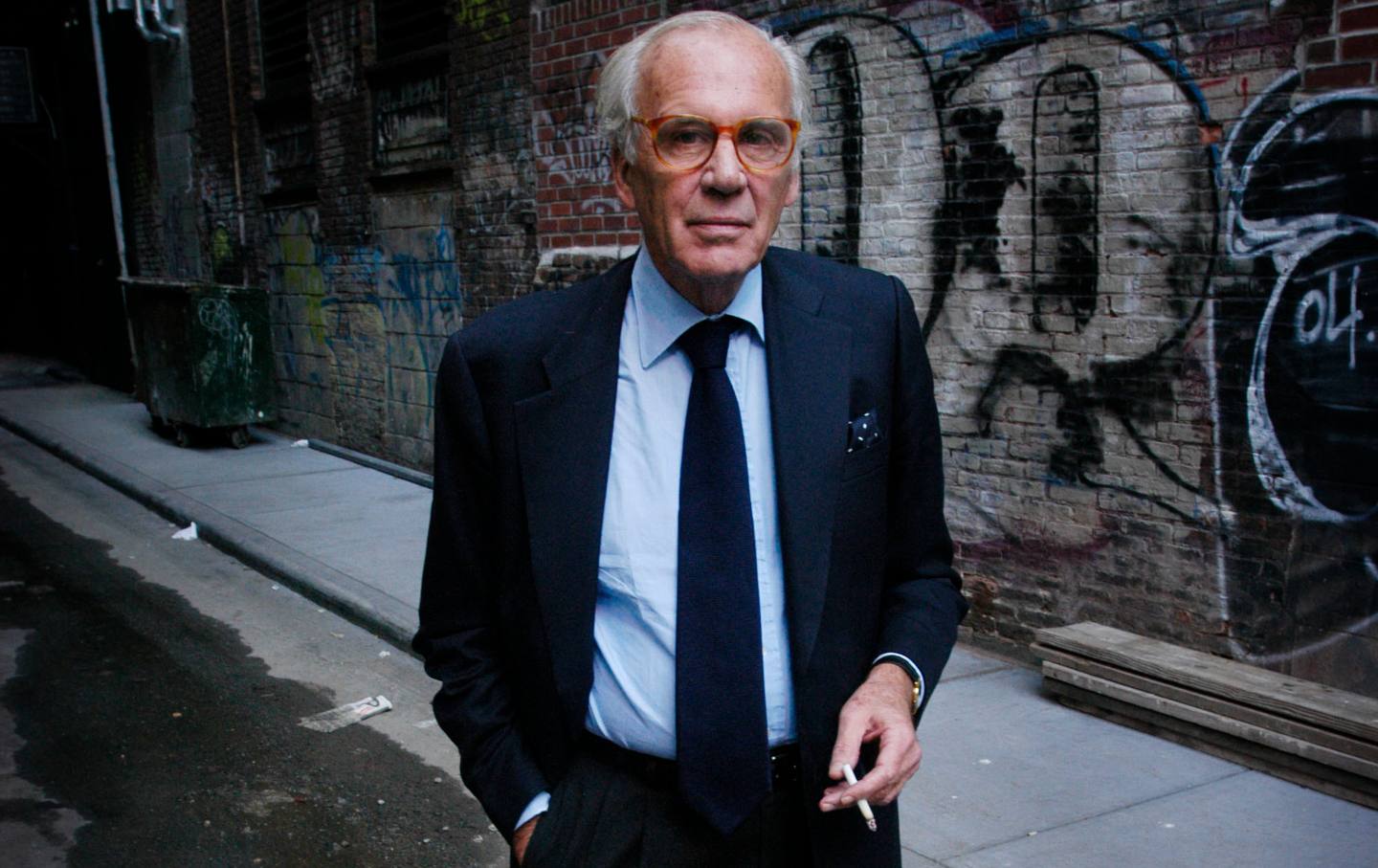
Lewis Lapham, the editor of Harper’s Magazine, stands near his office in 2004.
(Neville Elder / Corbis via Getty Images)
One night in 1969 at Elaine’s, a New York haunt for writers and show-business types on East 88th Street, the magazine writer Lewis H. Lapham ran into Willie Morris, a fellow regular and the editor of Harper’s Magazine, and pitched him a story. Oil had been discovered on the North Slope of Alaska, and Lapham proposed that Harper’s send him to Juneau for the winter to see what would happen once the state government got hold of $900 million in oil concessions. Would good government follow? Morris commissioned the essay, which was published in May 1970.
For Lapham, who died July 23 in Rome at age 89, the deal with Harper’s, where Morris made him a contributing writer, was welcome news, another outlet for his reporting in an industry that had been damaged by the rise of television.
After working as a newspaper reporter at the San Francisco Examiner and the New York Herald Tribune, Lapham had taken up magazine work, first at the short-lived USA 1 (which published for a year and was shuttered in 1962), then at The Saturday Evening Post (which folded in 1969), followed by Life (which was teetering on the edge and would end regular publication in 1972). His subjects included murder trials, profiles of Thelonious Monk and Julia Child, Lyndon Johnson’s White House, and the Maharishi Mahesh Yogi’s Spiritual Regeneration Movement. (Lapham was the only reporter to travel with the Beatles during their journey to study with the Maharishi in Rishikesh, India in early 1968.)
Less than a year after the Alaska report appeared, in what was covered as major literary news, Willie Morris resigned from Harper’s following disagreements with the magazine’s owners, and nearly the entire staff quit in protest. It suddenly seemed like Harper’s, founded in 1850 and the nation’s oldest monthly magazine, would close.
Though he had been to the offices only twice, Lapham offered to help keep the magazine going, worried that if Harper’s were shuttered, he would again be without a writing job. He assumed that his stint as an editor would be short-lived.
As it turned out, Lapham’s association with Harper’s would last more than 50 years. He became managing editor in 1971, first charged with making sure the magazine did not miss an issue, and then served as editor from 1976 to 1981 and again from 1983 to 2006, afterward taking the title of editor emeritus and founding a new magazine of history, Lapham’s Quarterly.
He had to learn the job of an editor on the fly, with many of the magazine’s former writers and their allies considering him akin to a scab. The departure of the magazine’s staff and nearly all its contributing writers, however, gave Lapham the chance to expand the magazine’s historically liberal remit by occasionally inviting contributions from conservative writers, including Irving Kristol and Norman Podhoretz, and pitching the revived magazine as a “theater of ideas.” The change was heresy to longtime readers.
Under constant pressure to bring in new pieces, he early on established the routine of taking home a stack of manuscripts each night, attempting to read nearly everything that landed on his desk, searching for writing in which he could hear the sound of a human voice.
Despite a patrician upbringing and high WASP trappings (tailored suits, summers spent in Newport, an encyclopedic knowledge of golf), he was open to any subject. His skills as a conversationalist and raconteur, often a surprise to those who had only encountered his formidable prose, soon attracted writers, editors, and story ideas in droves. (I was myself taken in by a pitch from Lapham 10 years ago, when he offered me a job as executive editor of Lapham’s Quarterly. He suggested we could save civilization and have fun at the same time.)
When commissioning an essay, he left specifics up to the writer, eschewing editorial memos and other formalities. He was particularly deft at generating story ideas over drinks after a day in the office, ignoring topics deemed important in literary and political circles and seizing on a subject that truly excited a writer.
“The hard thing was learning to play straight with a writer,” Lapham recalled in an interview. “Tell him or her right away if you weren’t going to accept the article. Don’t let the decision hang around, don’t blame the decision on some sort of committee.”
Shocked by the scale of the work required to run a monthly magazine, he often cited the usefulness of early advice given to him by a fellow New York editor: “Find people smarter than yourself and let them do the work.” Over his years at Harper’s, Lapham would become well-known for developing editorial talent, attracting young staffers with his zeal for the magazine and the promise of a meaningful seat at the table, despite the low salaries on offer. Generations of Harper’s staffers would go on to fuel New York’s top magazines.
After becoming head editor, Lapham began writing essays for Harper’s under the heading “Easy Chair,” taking over a column that had once been home to essays by Bernard DeVoto. His focus was American hypocrisy and an array of modern vacuities. He also took heretical positions on politics and skewered the world of wealth and privilege in which he was raised. Kurt Vonnegut called him “without doubt our greatest satirist” and praised the column as “elegant, honorable, learned, and fair.” He eventually published 14 books, many of them collections of his Harper’s essays.
He had a number of early successes as an editor, especially as one of the first champions of Annie Dillard. In addition to publishing many of her essays, he took on the book Pilgrim at Tinker Creek, which appeared via the imprint of Harper’s Magazine Press and won the Pulitzer Prize in 1975.
By 1980, however, the magazine’s owners had run out of patience with ongoing losses, then in excess of a million dollars a year, and set a date to cease publication. Once again the magazine was saved, this time through the partnership of Lapham and John R. MacArthur, an admirer of the magazine who put together a coalition to buy it and established the nonprofit Harper’s Magazine Foundation.
Lapham left the magazine in 1981, forced out by the new foundation he had helped create, which he claimed objected to his column “as unnecessarily critical of the American dream.”
In 1983 Lapham was rehired at Harper’s and went about redesigning the look and format of the magazine, in collaboration with MacArthur, by then in control of the Harper’s Magazine Foundation and then and now the magazine’s publisher, introducing its signature Readings and Index features and rechristening his column “Notebook.” The redesign debuted in 1984 (the same year as the Macintosh, as Lapham liked to emphasize) and received rave reviews. The magazine’s format remains nearly unchanged 40 years later.
More obituaries:
Though counterintuitive given that the magazine sometimes ran stories longer than 10,000 words, the redesign was premised on the idea that modern magazine readers had shorter attention spans. The Readings section pilfered from forthcoming books, articles from small magazines, and corporate and government documents, presenting the most interesting things that its editors had come across in the past month, some just a paragraph or two. The iconic Harper’s Index packed reams of paradoxical statistics on a single page.
Lapham also hoped to focus readers’ attention on a smaller group of essays than Harper’s had previously published, partly to distinguish the magazine from The New Yorker and The Atlantic but also to be sure that the magazine’s modest resources went as far as possible. “Take any five magazines and between all five of them they’re lucky to come up with 10 first-rate articles over the course of a whole year,” he recalled in a 2019 interview. “The Harper’s redesign allowed for one well-reported piece and one well-thought-out essay. I wasn’t forced to fill space.” (The relaunch also coincided with the end of Lapham’s flirtation with publishing conservative voices. Having been disenchanted by the election of Ronald Reagan, he moved the magazine reliably, if unpredictably, to the left.)
He hired Christopher Hitchens as Washington correspondent (sharing him with The Nation), which led to Hitchens’s two-part Harper’s story “The Case Against Henry Kissinger,” accusing Kissinger of war crimes. He was responsible, along with editor Charis Conn, for sending David Foster Wallace on a cruise ship, resulting in the now-classic essay “A Supposedly Fun Thing I’ll Never Do Again.” When over lunch the writer Barbara Ehrenreich suggested a reporter be assigned to write about the experience faced by millions of women entering the labor market in the aftermath of welfare reform, Lapham insisted she herself take up the assignment, which led to a series of Harper’s articles and her book Nickled and Dimed.
Lapham also lured Evan Connell, Eduardo Galeano, Edward Hoagland, Richard Rodriguez, Veronica Geng, Paul Fussell, and Marilynne Robinson to Harper’s and was proud to have debuted the writers Barry Lopez, John Jeremiah Sullivan, Donovan Hohn, and Matthew Power, along with Dillard.
Popular
“swipe left below to view more authors”Swipe →I started reading Harper’s in the late 1990s, when Lapham was in his 60s, and found it arresting, particularly the voice of its younger writers, a feat for an editor who entered journalism during the Eisenhower administration.
Lapham’s “Notebook” column also remained a remarkable regular event during this era, despite detractors who complained of its mandarin style, especially the column’s withering focus on the presidency of George W. Bush. During an era of vapid patriotism and conformity, Lapham was clear-eyed about America’s 2003 invasion of Iraq, which he opposed in a series of elegant columns. (The editors of The New Yorker, The Atlantic, and The New Republic all backed the war.)
Lapham liked to tell a story about his mother reading Moby-Dick aloud to him at age 6, reading a few pages each night on the condition that he could remember where the story had left off the night before. A childhood painting in Lapham’s archive from 1941, depicting a scene from Moby-Dick, seemingly confirms the story, providing early evidence of the intensity of his reading.
Born in 1935 in San Francisco, Lapham was raised in opulent privilege in the city’s Pacific Heights neighborhood. His great grandfather was a founder of the oil giant Texaco and his grandfather served as mayor of San Francisco; he also counted among his ancestors Henry Dearborn, Thomas Jefferson’s secretary of war.
At Yale College, from which he graduated in 1956, he read widely, drawn to Sir Thomas Browne, Gibbon, and Conrad as well as the historical novels of Balzac and Flaubert. He immersed himself in jazz and slinked around New York’s East Village hoping to catch glimpses of W.H. Auden. He also studied piano intensely. (In 1964, while writing a profile for the Post, he played a Beethoven piano sonata, rehearsed nearly daily for months, for Thelonious Monk, who acknowledged his performance with the enigmatic review, “I heard you.”)
After graduation he spent a year studying medieval English history at Magdalene College, Cambridge, studying under C.S. Lewis and meeting Ted Hughes and Sylvia Plath. His plan was to become a historian, but he soon learned he lacked the talent for footnotes and archival research that an academic career required. The reading of history would, however, return as a focus of his Notebook column.
“My object was to learn, not preach, which prevented my induction into the national college of pundits but encouraged my reading of history,” he wrote in 2010. “I borrowed the method of Montaigne, who measured the worth of his own observations against those that he came across in the archive of classical antiquity, most reliably in the writings of Plutarch and Seneca. I soon discovered that I had as much to learn from the counsel of the dead as I did from the advice and consent of the living.”
After 30 years at Harper’s—a magazine tenure that Jim Holt once likened to “geologic time”—Lapham retired from Harper’s and launched Lapham’s Quarterly, which debuted in 2007.
Each issue of the Quarterly focused on a single timeless theme—among them war, luck, money, religion, and epidemic—by bringing together short extracts from great works of history and literature, from ancient to contemporary and from around the world. The magazine also featured original maps and infographics and a selection of new essays on the theme at hand as well as a preamble by Lapham.
Inspirations for the Quarterly included the McGuffey Readers (school primers first published in the 19th century) as well as the mass circulation success of Reader’s Digest, and the continued relevance, 20 years after its launch and the rise of the internet, of the Harper’s Readings section. Lapham tirelessly promoted the magazine as an antidote to historical amnesia, with fundraising documents for the magazine leading with a quote attributed to the German poet Johann Wolfgang von Goethe: “He who cannot draw on three thousand years is living hand to mouth.”
Across more than 50 issues of the Quarterly, Lapham focused on voices that retained their power across time—ancient Chinese poetry, the Greeks and Romans, Montaigne, Shakespeare, Tolstoy, Virginia Woolf, and his beloved Mark Twain—writing that did not require footnotes to understand. (He often said his target reader was someone who wished they had paid more attention in school.) In his estimation it was the best magazine in the country.
His grand vision was for a mass democratic instrument of learning, brought to life by the craft of the magazine editor. In the decade I worked with Lapham on the Quarterly, I learned that there is no right or wrong answer for what makes great writing. A more apt lens for knowing what is worth reading and knowing is to ask what can survive what he called the “wreck of time,” writing that can reach across distance and circumstance and impart something true when filtered through the sensibility of a human voice.
“It isn’t with magic that men make their immortality,” Lapham wrote in a 2007 essay setting out the magazine’s mission. “They do so with what they’ve learned on their travels across the frontiers of five millennia, salvaging from the ruin of families and the death of cities what they find to be useful or beautiful or true. We have nothing else with which to build the future except the lumber of the past—history exploited as natural resource and applied technology, telling us that the story painted on the old walls and printed in the old books is also our own.”
More from The Nation

What Luigi Mangione and Daniel Penny Are Telling Us About America What Luigi Mangione and Daniel Penny Are Telling Us About America
When social structures corrode, as they are doing now, they trigger desperate deeds like Mangione’s, and rightist vigilantes like Penny.

Banning Trans Health Care Puts Young People at Risk of Harm Banning Trans Health Care Puts Young People at Risk of Harm
Contrary to what conservative lawmakers argue, the Supreme Court will increase risks by upholding state bans on gender-affirming care.

It’s Still Not Too Late for Biden to Deliver Debt Relief It’s Still Not Too Late for Biden to Deliver Debt Relief
Four years after hearing the president promise bold action on student debt, most borrowers are still no better off, and many—especially defrauded debtors—are measurably worse off....

It’s Been a Tough Year. Let’s Help Each Other Out. It’s Been a Tough Year. Let’s Help Each Other Out.
There may be a dark shadow hanging over this year’s holiday season, but there are still ways to give to those in need.

Prison Journalism Is Having a Renaissance. Rahsaan Thomas Is One of Its Champions. Prison Journalism Is Having a Renaissance. Rahsaan Thomas Is One of Its Champions.
Thomas and his colleagues at Empowerment Avenue are subverting the established narrative that prisoners are only subjects or sources, never authors of their own experience.

Luigi Mangione Is America Whether We Like It or Not Luigi Mangione Is America Whether We Like It or Not
While very few Americans would sincerely advocate killing insurance executives, tens of millions have likely joked that they want to. There’s a clear reason why.


